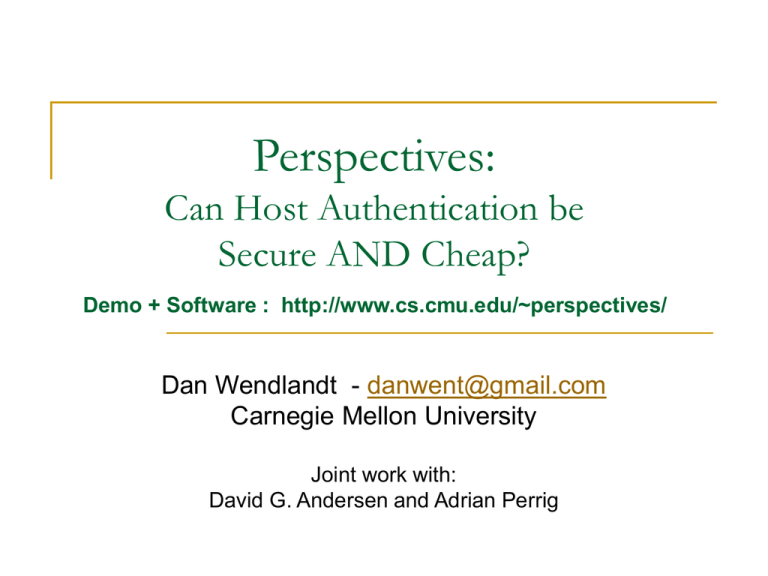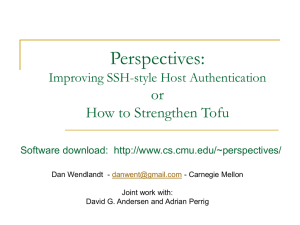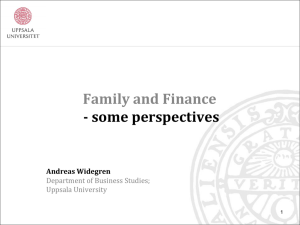Secure Communication with an Insecure Internet
advertisement

Perspectives: Can Host Authentication be Secure AND Cheap? Demo + Software : http://www.cs.cmu.edu/~perspectives/ Dan Wendlandt - danwent@gmail.com Carnegie Mellon University Joint work with: David G. Andersen and Adrian Perrig Why should you care? Using a traditional host PKI can be costly in $$ and admin time. Perspectives used automated network probing to create a “lightweight PKI”: Makes SSH/self-signed HTTPS more secure + useable. Potential to offer cheap alternative to existing PKI solutions. What I’m looking for: Your feedback / flames. If interested, your participation. download code at: http://www.cs.cmu.edu/~perspectives/ “Man in the Middle” (MitM) Attacks Alice needs Bob.com’s public key to establish a secure channel (e.g., SSL/SSH) to him. Hello,Bob.com secure channel Alice download code at: http://www.cs.cmu.edu/~perspectives/ K Bob.com “Man in the Middle” (MitM) Attacks Is K really Bob.com’s key? Hello,Bob “secure” channel Alice K Mallory If Alice accepts K, Mallory can snoop and modify all traffic! download code at: http://www.cs.cmu.edu/~perspectives/ Bob.com Do MitM Attacks Really Matter? Recent trends increase MitM vulnerability Other hosts on a wifi LAN can spoof ARP/DNS. e.g., ARPIFrame worm Known vulnerabilities in home routers/APs. e.g., “Pharming” attacks Recent “Kaminsky” DNS attack vector. Attacks are often automated & profit driven download code at: http://www.cs.cmu.edu/~perspectives/ Authenticating Public Keys Two standard approaches to handling MitM attacks: Public Key Infrastructure (e.g., Verisign certs) Prayer (e.g., SSH and self-signed HTTPS) download code at: http://www.cs.cmu.edu/~perspectives/ Prayer (aka SSH-style Authentication) Definition of SSH-style Authentication: 1) Pray for no adversary on first connection, cache key. 2) If key changes on a subsequent connection, panic! 3) If you feel lucky, pray again and connect anyway. download code at: http://www.cs.cmu.edu/~perspectives/ Why would anyone use prayer? Unlike a PKI, it is cheap and simple to use. A secure PKI traditionally requires: Costly (often manual) verification by a Certificate Authority Admin time to submit, install and replace certificates on each server. SSH-style auth requires neither cost. It is “Plug-and-Play” SSH quickly + ubiquitously SSH replaced telnet. download code at: http://www.cs.cmu.edu/~perspectives/ Our Approach: Strengthen the SSH Model We design “Perspectives” to: Keep SSH-style “Plug-n-Play” simplicity + low-cost. Significantly improve attack resistance download code at: http://www.cs.cmu.edu/~perspectives/ Perspectives Overview N K Is K really Bob.com’s key? Hello Bob.com Bob.com’s Key? K Bob.com’s Key? K Hello Bob.com Alice K Offered Key Client Policy K K, K, KBob.com’s Key? Secure Notary Observations Consistent Inconsistent K NHello Bob.com K Accept Key, Continue Reject Key, Abort Connection download code at: http://www.cs.cmu.edu/~perspectives/ N Bob.com K Hello Bob.com Perspectives: Attack Resistance Model Spatial Resistance: Multiple vantage points to circumvent localized attackers N N N download code at: http://www.cs.cmu.edu/~perspectives/ N Perspectives: Attack Resistance Model Temporal Resistance: Key history raises alarm even if all paths are compromised. K K N N K N K download code at: http://www.cs.cmu.edu/~perspectives/ N Perspectives: Attack Resistance Model Temporal Resistance: Key history raises alarm even if all paths are compromised. K,K K, K, N N K, K N K ,K download code at: http://www.cs.cmu.edu/~perspectives/ N Perspectives: Attack Resistance Model Temporal Resistance: Key history raises alarm even if all paths are compromised. K, K, K K, K, K N N K, K, K N N Not bullet-proof, but significantly improvesK,attack resistance. K, K download code at: http://www.cs.cmu.edu/~perspectives/ Perspectives Design Who runs these network notaries? How do notaries monitor keys/certificates? How do clients securely retrieve notary data and decide to accept or reject a key? download code at: http://www.cs.cmu.edu/~perspectives/ Who runs “network notary” servers? Could be single player (e.g., Mozilla, Google, or EFF) Or a “community deployment” with ISPs, universities, webhosts, etc. volunteering single nodes. Similar to: Public traceroute & looking-glass servers Academic network testbeds like PlanetLab and RON. Our design + security analysis assumes that some notaries may be malicious/compromised at any time. download code at: http://www.cs.cmu.edu/~perspectives/ Who runs “network notary” servers? Currently targeting 10-30 global notary servers. “master” public key shipped with client software. Clients regularly fetch & verify a “notary list”: [notary ip, notary public key] [notary ip, notary public key] …… [notary ip, notary public key] download code at: http://www.cs.cmu.edu/~perspectives/ How do notaries monitor keys? Notary Server Probing Modules HTTPS SSH Notary Database HTTPS SSH www.shop.com:443 www.cs.cmu.edu:443 ….. www.secure.net:443 shell.foo.com:22 login.bar.net:22 ….. host1.cmu.edu:22 Protocol-specific probing modules mimic client behavior. Notary regularly (e.g. daily) probes each service listed in database and updates its info. download code at: http://www.cs.cmu.edu/~perspectives/ Notary Database Records Service-id: www.shop.com:443, HTTPS Key: 32:AC:21:5D:DE:43:73:E9:3A:EE:90:BC:17:C4:8F:36 Timespan: Start: Jan 9th, 2008 - 3:00 pm End: Apr. 23rd, 2008 – 8:00 am Key: F3:76:00:EC:D0:8E:DB:20:BC:2B:E0:06:60:24:C4:9F Timespan: Start: Apr, 23th 2008 - 3:00 pm End: Jun 27, 2008 – 8:00 am HTTPS www.shop.com:443 www.cs.cmu.edu:443 ….. www.secure.net:443 Signature Created with Notary’s private key download code at: http://www.cs.cmu.edu/~perspectives/ How do clients receive notary data? Firefox HTTPS: www.shop.com Port 443 Notary Client Code key & timespan info signature Notary DB Verify using notary’s public key Query & Response are UDP datagrams, like DNS. Attacker cannot “spoof” notary reply. download code at: http://www.cs.cmu.edu/~perspectives/ Client Policies to accept/reject a key. Test spatial and temporal “consistency”. Many possible approaches to policies: Manual (power users) or Automatic (normal users) download code at: http://www.cs.cmu.edu/~perspectives/ Manual Key Policies: Power Users Give sophisticated users more detailed info: 6/6 notaries have consistently seen the offered key from this service over the past 200 days. 4/6 notaries currently see a different key! All notaries have seen the offered key for the past 8 hours, but previously all consistently saw key Y! Power user would determine if offered key passes a “consistency threshold”. download code at: http://www.cs.cmu.edu/~perspectives/ Automated Key Policies: Normal Users Automated “Consistency Thresholds” can be tailored to the individual client’s high-level security needs: I really want to connect, If anything is fishy, just make sure I’m be safe and don’t High Security High Availability protected against connect. simple (e.g., wifi) attacks. 100% of Notaries At least 50% of have seen offered key consistently for the past 3 days. Notaries currently see offered key. Our paper provides a detailed description and security analysis. download code at: http://www.cs.cmu.edu/~perspectives/ The Story so Far… Traditional PKI model is costly and cumbersome. Perspectives retains the low-cost and simplicity of SSH-style authentication while greatly improving attack resistance. Not bullet-proof, but provides a security trade-off suitable for many non-critical websites. download code at: http://www.cs.cmu.edu/~perspectives/ Three Potential uses of Perspectives download code at: http://www.cs.cmu.edu/~perspectives/ #1: Strengthen existing use of SSH and self-signed SSL Recent changes to IE and Firefox make self-signed certs harder to use. More than 10K people have downloaded and used our Firefox extension. download code at: http://www.cs.cmu.edu/~perspectives/ #2: Alternative for “low-end” CA-signed certs. The HTTPS certificate market is splitting: High-end certificates granted after manual verification of real-world identity. (e.g., Extended Validation) Low-end certificates granted after automated email to WHOIS address. (e.g., Godaddy.com) Cheap but less secure Secure but expensive download code at: http://www.cs.cmu.edu/~perspectives/ #2: Alternative for “low-end” CA-signed certs. Compared to current “low-end”, Perspectives: Offers comparable security: Is more convenient for server admins: A widespread attacker can likely spoof “verification” emails. This spoofing attack need not be long-lasting. No need to manually request/install a cert. Plays nicely with virtual hosting on a shared IP address. Is based on freely available data: Server owners do not pay yearly “certificate tax”. Clients can make an individualized security trade-off. download code at: http://www.cs.cmu.edu/~perspectives/ #3: Provide an additional layer of security for root-signed SSL certificates If an attacker can trick or compromise any one of the 30+ CAs, it can potentially spoof any website. A client can detect that the attacker’s cert differs from the cert being seen by Notaries. Also, website owners/third parties can monitor notary data to proactively detect attacks. download code at: http://www.cs.cmu.edu/~perspectives/ Publicly Available Notary Deployment Currently running on the RON testbed. Probes new services “on-demand”, adds them to DB. Existing Notary Clients: OpenSSH: Firefox 3: Query via Web: If you can’t install software on the client. “power user” policy if key is not cached. Automatically overrides security error page if notary data validates key. download code at: http://www.cs.cmu.edu/~perspectives/ Notary Server Benchmarks Modern Server: Probes / day Queries / Sec 16.8 million 25,000 2.2 million 21,000 4-core 2GHz, 8 GB RAM 3 year-old Workstation: 1-core 2.4GHz, 512MB RAM Good News: Current probing code is highly UNoptimized. Operations are “trivially parallel” => easily scales with addition machines/cores. download code at: http://www.cs.cmu.edu/~perspectives/ Thanks! Source and binaries available at: http://www.cs.cmu.edu/~perspectives/ Interested in helping? danwent@gmail.com Academic Paper: http://www.cs.cmu.edu/perspectives_usenix08.pdf download code at: http://www.cs.cmu.edu/~perspectives/ Back-up / Question Slides download code at: http://www.cs.cmu.edu/~perspectives/ Notary Bandwidth Requirements: Single Probe: Probe 1 million hosts / day Client queries + responses. Upstream Downstream SSL 0.5 KB 2.0 KB SSH 1.5 KB 2.3 KB Upstream Downstream SSL 46 kbps 185 kbps SSH 138 kbps 213 kbps Upstream Downstream Single 60 bytes 315 bytes @ 10 million / day 55 kbps 292 kbps download code at: http://www.cs.cmu.edu/~perspectives/ What about DNSSEC? Changing core protocols is painstaking work, adoption is uncertain. Unclear how, if at all, DNSSEC verification of domain ownership will improve on the current “spoofable” model of email verification. Still requires manual administration: Server admins must still request/install certs. Domain-owner must act as CA for all machines in the domain. download code at: http://www.cs.cmu.edu/~perspectives/ But SSL Certificates are Cheap! 1) 2) 3) Cheap certs use automated email verification. Mimics notary probes, but makes less appealing trade-offs. Consider that: Server owner must still manually generate, request, install cert. An attacker powerful enough to fool Perspectives could often spoof an email response. Only a single CA must be fooled, and the attack need only last long enough to request a cert. download code at: http://www.cs.cmu.edu/~perspectives/ Notaries and User Privacy Issue: A malicious notary might record (request src-IP, service-id) pairs to try and “track” users. A legitimate concern, but not a deal-breaker: Source IP is an increasingly weak identifier of a human user (NAT/DHCP). Source ISP already sees all traffic. Clients need only query when key is not cached. This is relatively infrequent, and a trade-off used to mitigate risk Paper discusses possibility of DNS being used as a proxy to hide source IP. Long-term: servers act as intermediary to retrieve notary results, completely protecting client privacy. download code at: http://www.cs.cmu.edu/~perspectives/ Limitation: Clients directly contact Notaries The Problem: System vulnerable to widespread Notary failures or denial-of-service. Privacy concerns. Notary query could expose (client IP, service-name) pairs. download code at: http://www.cs.cmu.edu/~perspectives/ Limitation: Clients directly contact Notaries In the short-term: Static notary replies are amenable to CDNs. Querying via a proxy (e.g., using DNS) provides anonymity + caching benefits. In the long-term: A destination server could proactively fetch + cache notary results for its own name. Clients would not contact notaries at all. download code at: http://www.cs.cmu.edu/~perspectives/ Other Related Work Portable SSH key cache [Ali & Smith] Centralized repository for all keys seen by a user Helps if user sees the same new key from different source machines. No help first time user connects or sees a new key. SSH key fingerprints in DNS [RFC 4255] Requires DNSSEC, each DNS admin must act as Cert. Authority Web Tripwires [Reis, et al] In-band Javascript detects modifications, but can be removed by an atacker. Concurrent Work: On-demand HTTPS cert. verification [Stone-Gross, et al] HTTPS-only, no temporal history, simplified security model. download code at: http://www.cs.cmu.edu/~perspectives/ Automated Key Policies: Normal Users Quorum must be a fraction of the total number of queried notaries, not responses received. Notary #1 Notary #2 Notary #3 KA KA KA Notary #4 KB Notary #5 KA Adversary on client link can selectively drop notary replies. download code at: http://www.cs.cmu.edu/~perspectives/ Perspectives and ConfiDNS They have a cooler name Same intuition: spatial + temporal diversity Different problems resulted in different design decisions: ConfiDNS focuses on bad local DNS resolver, we focus compromise of arbitrary network elements. DNS-to-name mappings legitimately differ more frequently than hostname to key mappings (e.g., locality based load balancing). download code at: http://www.cs.cmu.edu/~perspectives/ Security vs. Availability Trade-off Legitimate key change is indistinguishable from an attack that is both widespread and long-lasting. A client that sets a high quorum duration threshold to increase attack resistance would reject any new key for the same amount of time, even if it is legitimate. download code at: http://www.cs.cmu.edu/~perspectives/ Security vs. Availability Trade-off In the short-term: Clients can set QD based on individual needs. No free lunch: services with stringent security & availability needs should use root-signed certs. In the long-term: A destination server could detect attacks and alert administrators by periodically querying notaries for its own name. Clients would not contact notaries at all. download code at: http://www.cs.cmu.edu/~perspectives/ How to Improve SSH-style Authentication? SSH-style clients warn the user and ask her to make a security decision The frequent “content free” warnings are usually ignored. Perspectives provides additional data to distinguish between an attack and a spurious warning. download code at: http://www.cs.cmu.edu/~perspectives/ Automated Key Policies: Normal Users quorum: a minimum threshold of notary agreement needed to consider a key valid. Example: client configured with quorum of 75% Notary #1 Notary #2 Notary #3 KA KA KA Notary #4 KB Notary #5 KA If offered key is KA: 80% > 75% Accept download code at: http://www.cs.cmu.edu/~perspectives/ Automated Key Policies: Normal Users Define “quorum duration” : given quorum threshold, the length of time a particular key has held quorum. download code at: http://www.cs.cmu.edu/~perspectives/ Automated Key Policies: Normal Users Define “quorum duration” : given quorum threshold, the length of time a particular key has held quorum. Duration = 2 days Accept Key Example Threshold: Quorum = 0.75 Notary #1 Notary #2 Notary #3 Notary #4 Notary #5 3 days KA KA KB KA 2 days KA KA KA KA 1 day KA KA KA KA Duration download code at: http://www.cs.cmu.edu/~perspectives/ Key Policies: Normal Users Define “quorum duration” : given quorum threshold, the length of time a particular key has held quorum. Duration = 3 days Reject Key! Example Threshold: Quorum = 0.75 Notary #1 Notary #2 Notary #3 Notary #4 Notary #5 3 days KA KA KB KA 2 days KA KA KA KA 1 day KA KA KA KA Duration download code at: http://www.cs.cmu.edu/~perspectives/ The Security vs. Availability Trade-off Fundamental SSH-style authentication trade-off: Clients gain security at the cost of availability (i.e., rejecting a key and disconnecting). Quorum duration flexibly encodes this trade-off: Higher quorum threshold is more secure: => but client is more likely to reject valid key due to notary compromise or failure. Higher quorum duration threshold is more secure: => but client rejects valid servers with new keys. download code at: http://www.cs.cmu.edu/~perspectives/







